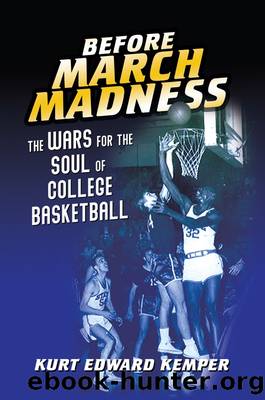Before March Madness by Kurt Edward Kemper

Author:Kurt Edward Kemper
Language: eng
Format: epub
Publisher: University of Illinois Press
Published: 2020-08-15T00:00:00+00:00
CHAPTER 6
HOME RULEâS LAST REDOUBT
RACE, THE NCAA, AND COLLEGE BASKET BALL IN MID-CENTURY AMERICA (1950â1955)
At the end of the 1950 NCAA Annual Convention, which that year had been held in New York, the NCAA innocuously announced that the following yearâs event would be held in Dallas, Texas. It was only the second time in the associationâs history that the convention had been awarded to a Southern city, the first being New Orleans in 1937, and many in the media interpreted the decision not only as an example of the associationâs growth and increased national prestige but also as an attempt to show the flag in a region that had been only lukewarm about the associationâs designs on national guidelines for football and its efforts to assert itself as the standard-bearer on amateurism. What received no media attention at the time, however, was that the Hotel Adolphus in Dallas was segregated. The NCAA had held its conventions before in segregated facilities, but it seemed unaware of the changing social, cultural, and political outlooks and how the grounds of egalitarianismâor at least the appearance of itâwere shifting beneath its feet. The 1951 NCAA Convention in Dallas would be held amid a changed landscape that included the advances of black pioneers in American professional sports as well as the growing commitment of the federal government, the American military, and the national Democratic Party to oppose segregation. It also rather inconveniently occurred just as its key leadership was then attempting to fend off concerns from its black membership of NCAA indifference to racial antipathy and to convince them that the inability of historically black colleges to gain access to the NCAA Basketball Tournament had nothing to do with race or a discriminatory selection process. In the rapidly evolving racial politics of postwar America, race men like North Carolina Collegeâs John McLendon and his allies on both sides of the color line successfully managed to embarrass an increasingly defensive NCAA while simultaneously supporting the NAIA in its forceful embrace of sporting equality.
The road to Dallas, however, began even earlier than the previous yearâs convention in New York. Its contours first appeared in the NCAAâs bungled response to the petition from the HBCs seeking admission to the NCAA Basketball Tournament. McLendon and his committee examined the concerns of the NCAA Basketball Committee and attempted to identify compromises that might demonstrate their flexibility to the tournament committee. They naively assumed the NCAA would approach their request the same way. Acknowledging that the presence of Southern segregated schools in the NCAA Tournament meant that the current âplan of elimination of teams through district and regional play-offs ⦠will not be integrated in our day,â McLendon and his committee proposed that the four HBC conference champions play each other, with the top two advancing to the NCAA Tournament. Penn Stateâs John Lawther, the executive secretary of the National Association of Basketball Coaches, who first fielded the petition, continued to offer his encouragement and advice, but by February 1949 the NCAA had yet to formally acknowledge the proposal.
Download
This site does not store any files on its server. We only index and link to content provided by other sites. Please contact the content providers to delete copyright contents if any and email us, we'll remove relevant links or contents immediately.
